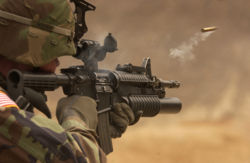Army: Difference between revisions
Jump to navigation
Jump to search

John Leach (talk | contribs) m (Text replacement - "general" to "general") |
John Leach (talk | contribs) (restored Eric's version in May 2008; needs expansion) |
||
| Line 1: | Line 1: | ||
{{subpages}} | {{subpages}} | ||
[[Image:Casing.jpg|thumb|250px| A U.S. Army soldier firing a 5.56 mm round from an M4 rifle (the M4 also has an M203 | [[Image:Casing.jpg|thumb|250px| A U.S. Army soldier firing a 5.56 mm round from an M4 rifle (the M4 also has an M203 Grenade Launcher attached).]] | ||
An '''Army''' is a term either referring to the largest type of [[formation]] for a land-based military force, or the entirety of a nation's military force responsible for its land defenses, both of which are composed of [[Soldier|soldiers]], trained to engage in [[war]]. | |||
An army, as a single in-theater force, operates at a [[ | An army, as a single in-theater force, operates at a [[Strategy|strategic]] level, but is composed of and often divided into smaller operational units which operate at a [[Tactics|tactical]] level. It is also characterized by a command hierarchy utilizing ranks (divided between [[Officer|officers]] and [[enlisted]], but often with a [[non-commissioned officer]] corps as well), with a rigid adherence to protocol and chain of command necessitated by the conditions of war. | ||
==References== | ==References== | ||
{{reflist}} | {{reflist}} | ||
[[Category:Reviewed Passed if Improved]] | |||
Latest revision as of 03:37, 27 March 2024
An Army is a term either referring to the largest type of formation for a land-based military force, or the entirety of a nation's military force responsible for its land defenses, both of which are composed of soldiers, trained to engage in war.
An army, as a single in-theater force, operates at a strategic level, but is composed of and often divided into smaller operational units which operate at a tactical level. It is also characterized by a command hierarchy utilizing ranks (divided between officers and enlisted, but often with a non-commissioned officer corps as well), with a rigid adherence to protocol and chain of command necessitated by the conditions of war.
